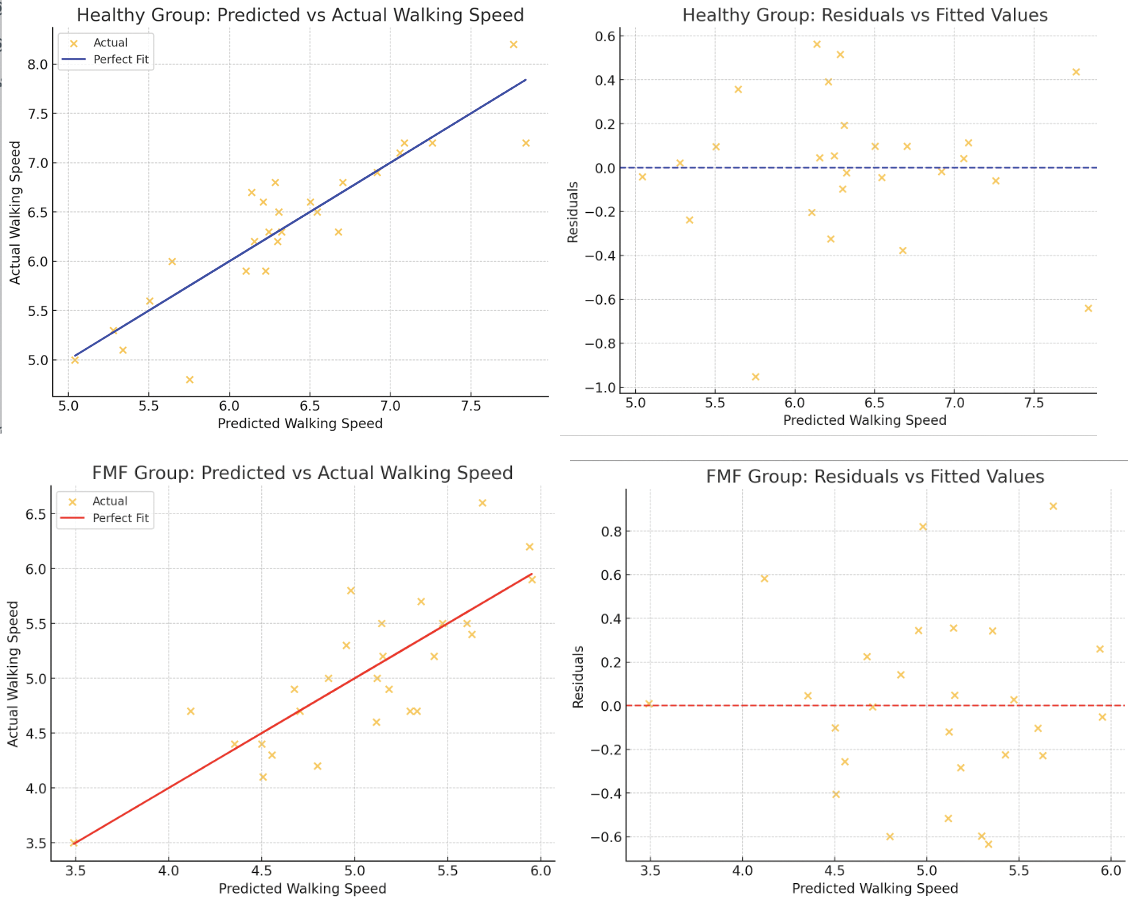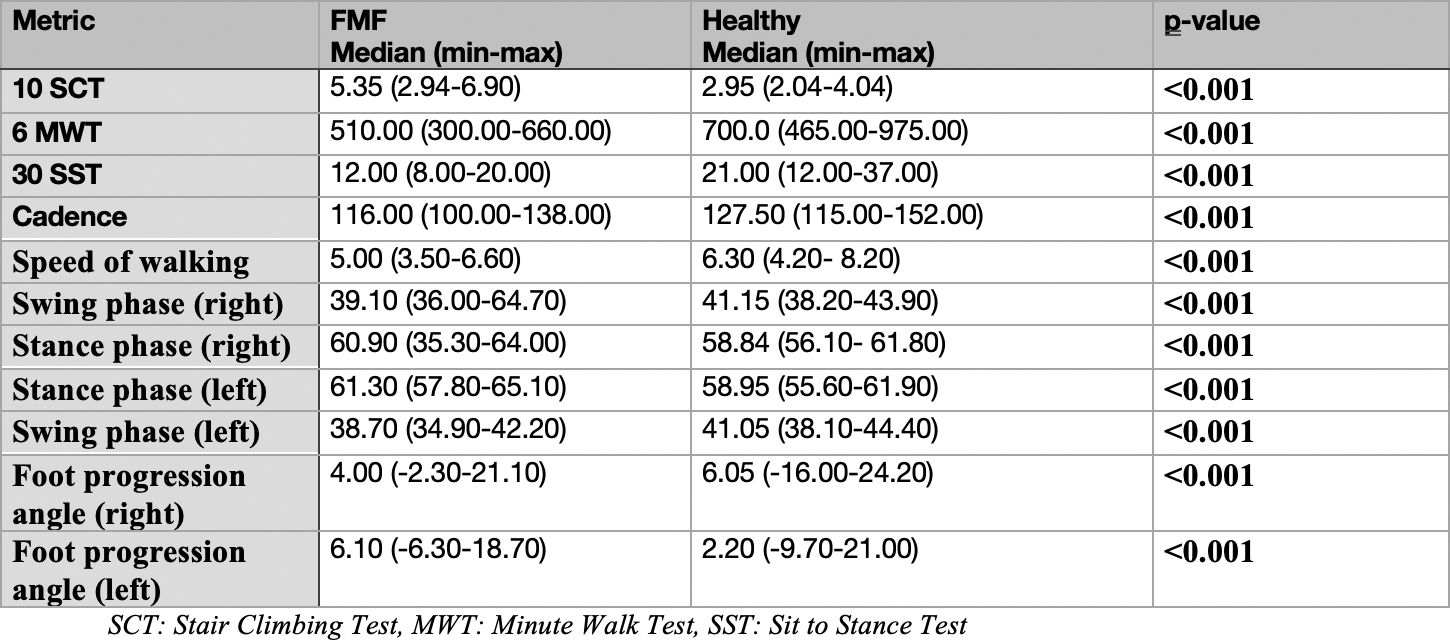

Background: Children with Familial Mediterranean Fever (FMF) often experience issues such as joint pain, swelling, decreased range of motion, and fatigue, which affect their locomotor functions and gait parameters. These challenges are particularly pronounced in weight-bearing joints, potentially altering gait mechanics and functional performance. Understanding the relationship between gait characteristics and locomotor functions is crucial for developing targeted interventions [1, 2].
Objectives: This study aimed to evaluate gait characteristics using a smart insoles system and assess their relationship with locomotor functions in children with FMF. The results were compared with healthy peers to highlight differences and inform rehabilitation strategies.
Methods: This study included 23 children with FMF (12 girls, 11 boys) and 23 healthy controls (6 girls, 17 boys) aged 11 to 18 years. Gait parameters, including cadence, walking speed, foot progression angle, and stance and swing phases for both lower extremities, were assessed using the Smart Insoles System. Locomotor functions were evaluated using the 30-Second Sit-To-Stand Test (lower extremity endurance), the 6-Minute Walk Test, and the 10-Stair Climbing Test (functional capacity). Statistical analysis included the Mann-Whitney U test for nonparametric group comparisons, Pearson correlation analysis to identify relationships between variables, and multiple linear regression analysis to determine predictors of walking speed (Figure 1).
Results: Children with FMF demonstrated significant differences in gait characteristics and locomotor functions compared to their healthy peers (Table 1). Walking speed (5.03±1.2 m/s) was significantly lower in children with FMF than in healthy controls (6.25±0.9 m/s) (p<0.001). Similar trends were observed in the distance of the 6-Minute Walk Test, cadence, swing phase percentage, and 30-Second Sit-To-Stand Test scores, which were all reduced in the FMF group (p<0.001). Conversely, children with FMF exhibited higher 10-stair climbing times, stance phase percentages, and foot progression angles compared to healthy children (p<0.001). Correlation analysis revealed significant relationships between locomotor functions and gait parameters. In the FMF group, the distance of the 6-Minute Walk Test was positively correlated with walking speed (r=0.60, p<0.001) and cadence (r=0.46, p<0.05). Similarly, the score of the 30-Second Sit-To-Stand Test was significantly associated with walking speed and swing phase percentages (p<0.05). In healthy children, walking speed showed a strong correlation with cadence (r=0.85, p<0.001) and stance/swing phase percentages (p<0.05). Regression analysis identified distinct predictors of walking speed in each group. In children with FMF, the distance of the 6-Minute Walk Test was the strongest determinant of walking speed, explaining 66.3% of the variance (p=0.003). In contrast, cadence was the primary determinant in healthy peers, accounting for 81.4% of the variance (p=0.001).
Conclusion: Children with FMF exhibit significant alterations in gait characteristics and locomotor functions compared to their healthy peers. These alterations include decreased endurance, slower walking speed, and disrupted gait mechanics, characterized by increased foot progression angles and prolonged stance phases. These findings suggest that FMF-related fatigue, muscle weakness, and pain contribute to these differences. The study highlights the interplay between locomotor functions and gait parameters. Endurance emerged as the critical factor influencing walking speed in FMF children, while cadence primarily determined walking speed in healthy individuals. These results underscore the importance of individualized rehabilitation programs targeting endurance and pain management in FMF patients and gait optimization in healthy adolescents. Future research should further explore the roles of fatigue, proprioception, and joint health in shaping mobility outcomes in FMF, aiming to develop holistic therapeutic strategies that improve mobility and quality of life for these patients.
REFERENCES: [1] Alayli, G., et al. (2014). Functional capacity, strength, and quality of life in children and youth with familial Mediterranean fever. Pediatric Physical Therapy.
[2] Elhani, I., et al. (2024). Physical fitness in adolescent patients with familial Mediterranean fever. Rheumatology International.
Predictors of Walking Speed of Multiple Linear Regression Analysis

Table 1. Comparison of Locomotor Functions and Gait Parameters Between Groups

Acknowledgements: NIL.
Disclosure of Interests: None declared.
© The Authors 2025. This abstract is an open access article published in Annals of Rheumatic Diseases under the CC BY-NC-ND license (